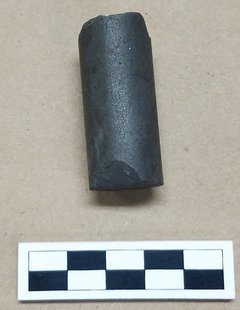A hard carbon rod was recovered from the Excavation Unit located north of the reconstructed wall of the Sacristy, north of the Church. The carbon rod is the interior core of a dry-cell battery.
The first batteries may have been invented between 200 B.C.E and 600 C.E. The early batteries consisted of clay jars containing a liquid and metal that could produce a small charge. Centuries later, experimentation with the concept led to batteries that could produce larger charges. Circa 1886, the first dry-cell batteries were invented, removing the need to have a liquid as the medium to conduct electricity. These batteries could produce up to 1.5 volts of direct current.
These dry-cell batteries would have been used to power household object as well as machines and cars (car battery). Similar carbon battery cores have been encountered at other historic sites in San Antonio and Texas that exhibit a later 19th century occupation.
Archival resources detailing the late 19th and early 20th centuries occupation of the Alamo grounds have shown a car dealership and mechanic garage on the premises. It is possible that this battery core could potentially be related to the car batteries from the dealership or mechanic garage.


